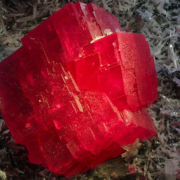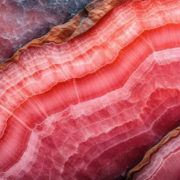Rhodochrosite stone – properties, virtues & benefits
Rhodochrosite is a bright Pink gemstone valued for its healing properties and aesthetic qualities. It is often associated with love, compassion and emotional healing, and is used in jewelry and lithotherapy. Discover the characteristics and benefits of this unique stone.
CHARACTERISTICS OF RHODOCHROSITE
- Chakra: Heart.
- Properties: Love, compassion, emotional healing, self-confidence, creativity.
- Astrology: Venus.
- Zodiac: Taurus, ScorPio.
- Elements: Fire, Earth, Water.
- Colors: Pink, red, white, yellow.
- Hardness: 3.5 – 4 on the Mohs scale.
- Chemical Formula: MnCO3 (manganese carbonate).
- Associated god: None.
RHODOCHROSITE – HIS HISTORY
Rhodocrosite, a Pink-colored stone, was discovered in copper and silver mines in northwest Argentina during pre-Columbian times. Its name comes from the ancient Greek “rhodon”, meaning rose, and “khroma”, meaning color. At the time of the Inca EmPire, the stone was considered a representation of the fossilized blood of ancient rulers, but fell into oblivion after the fall of the emPire.
According to Inca legend, a warrior named Canqui Tupac fell in love with the beautiful priestess Nusta Ajlla, who lived in the Ajllas temple on the shores of Lake Titicaca. As their union was forbidden, they had to flee south. After many years together and many children, Nusta died and her body was buried on a nearby mountaintop. Canqui’s body turned to rock when she died. Years later, a shepherd discovered that the stones had metamorphosed into red rose petals. When one of these petals was presented to the Emperor of the Incas, he was moved and forgave the lovers. Since then, the stone has been considered a symbol of forgiveness, loyalty, sacrifice and true love, and is known as Rosa del Inca in Inca culture.
In the 18th century, rhodocrosite-containing mines were rediscovered and named “carbonated oxidized manganese” by Abbé René Just Haüy in 1806 in his work “Tableau méthodique des espèces minérales”. In 1813, the German mineralogist Johann Friedrich Ludwig Hausmann renamed it “rhodochrosite”, a name approved by the IMA. The first mention of the stone’s presence in the Sierra CaPillitas mines in Argentina dates from 1871 to 1874, thanks to the research of Alfred Stelzner, a German geologist and mineralogist.
.
Rhodochrosite became world-famous in the late 1930s thanks to Franz Mansfeld, who discovered rhodocrosite fragments at the Plate Museum in Buenos Aires and managed to obtain a sample of the stone, which he had polished. After discovering an Inca tomb containing rhodocrosite jewelry in Catamarca province, he nicknamed the mineral the “Rosa del Inca” and transformed several tons of stone in a cutting and polishing workshop. He exhibited his carved rhodocrosite creations at the Leipzig International Fair in 1938, marking the beginning of the stone’s international popularity. Since then, rhodochrosite has become the national stone of Argentina and the official stone of the state of Colorado in the U.S.
.
RHODOCHROSITE STONE – ITS ORIGIN AND COMPOSITION
Rhodocrosite is a stone with a rhombohedral crystal system that comes in several varieties. CaPillitite is a ferro-zinciferous variety of rhodochrosite whose only known deposit is at the CaPillitas mine in Argentina. Cobalto-rhodochrosite is a cobalt-rich variety whose only known deposit is the Virneberg mine in Germany. Ponite is an iron-bearing variety considered the core value of the rhodocrosite-siderite series. Sphaerodialogite is a small nodular variety found in manganese ores, and has only been found at the Gwynedd mine in Wales. Finally, zincorhodochrosite is a zinciferous variety of rhodocrosite.
Rhodochrosite belongs to the calcite group, a group of isostructural minerals that have the same overall chemical formula. Other minerals in this group include Calcite, Gaspeite, Magnesite, Otavite, Siderite, Smithsonite and Sphaerocobaltite. Rhodochrosite crystals are transparent or translucent with a pearly luster. In its purest form, it is Pink and red in color, but more often oscillates between Pink and light brown, with white bands. The presence of manganese in its composition explains this coloring. Rhodochrosite crystals can reach lengths of 12 cm, but the largest crystal, Alma King, was discovered in 1992 in Colorado and measures 14×16.5 cm.
Rhodochrosite can be used as an ornamental stone or cut to become a collector’s gem in the form of necklaces or bracelets. It can also be consumed directly as an elixir for a more effective action. Although there are many rhodochrosite deposits around the world, few offer quality crystals. The Cape Town mine in South Africa and the Mounana mine in Gabon, however, offer quality crystals. New deposits have also recently been discovered in Peru, China, Romania and Greece.
.
In France, numerous rhodochrosite deposits are found, notably in the Pyrenees, around Guingamp in Brittany, at Faucogney-Saphoz in Haute-Saône and at Mas d’Alary in Hérault.

NATURAL RHODOCHROSITE STONE – VERTIES AND PROPERTIES
HRODOCHROSITIS ON THE PSYCHOLOGICAL LEVEL
Rhodocrosite is known as the stone of love and compassion. It gently treats buried emotional wounds. Wearing this stone daily promotes a positive attitude and can be beneficial when practicing meditation to renew energies. Rhodocrosite also helps balance the heart and solar plexus chakras, which are closely linked to emotions. It acts on the heart chakra to regulate emotions and feelings, and on the solar plexus chakra to reduce stress and boost self-confidence.
PHYSICAL RHODOCHROSITIS
In addition to its mental health benefits, rhodochrosite can also have beneficial effects on physical health. It helps eliminate toxins in the liver and kidneys, calms gastric problems, regulates blood sugar levels, revitalizes the nervous system and improves sleep. It can also help calm stress attacks.
If you suffer from skin disorders, rhodochrosite can also have beneficial effects, such as calming facial redness and skin disorders. However, for some of these physical disorders, wearing rhodochrosite as a necklace or bracelet may not be enough, and it is recommended to consume it directly as an elixir to promote the circulation of energies.

ROSE RHODOCHROSITE STONE – CLEAN AND RECHARGE
To clean your rhodochrosite stone, you can use distilled water or salt water. Avoid cleaning it with running water, as it can be abrasive. You can also use energetic purification methods such as sage or palo santo fumigation, direct sunlight or moonlight, or the practice of Reiki.
To recharge your rhodochrosite stone, place it where it can be exposed to natural sunlight or moonlight for several hours. You can also place it on a cluster of quartz crystals or geodes, or use meditation or visualization techniques to recharge it with your personal energy. Be sure to recharge your rhodochrosite stone regularly to maximize its healing properties.
WHERE DOES THE NAME RHODOCHROSITE COME FROM?
The name “rhodochrosite” comes from the Greek “rhodon” meaning “rose” and “chroma” meaning “color”. This refers to the stone’s distinctive color, which is often Pink or red. Rhodochrosite was first described in 1813 by German geologist Friedrich Mohs, who identified the stone as a manganese carbonate. Today, rhodochrosite is mined mainly in Argentina, but is also found in other parts of the world, including the USA, Peru, Russia and South Africa.
WHICH CHAKRA DOES RHODOCHROSITIS ACT ON?
Rhodochrosite is often associated with the heart chakra, located in the center of the chest. This chakra is considered the center of love, compassion, emotional healing and self-acceptance. By working with rhodochrosite, you can help balance and stimulate the energy of your heart chakra, enabling you to connect more deeply with your emotions, open your heart to love and joy, and free yourself from emotional blockages.
WHICH ASTROLOGICAL SIGN IS ASSOCIATED WITH RHODOCHROSITIS?
Rhodochrosite is associated with the astrological signs of Taurus and ScorPio. People born under these signs can benefit from rhodochrosite’s properties, which include love, compassion, emotional healing and self-confidence. However, this does not mean that only people born under these signs can use this stone. Rhodochrosite can benefit everyone, regardless of their astrological sign.
SUMMARY OF THE RHODOCHROSITE STONE
Rhodochrosite stone is a Pink to orange-red semi-precious stone often used in jewelry and jewelry. It is composed of manganese carbonate and can be found in deposits all over the world, including Argentina, South Africa and the USA.
Rhodochrosite is considered a stone of love and compassion, which can help heal emotional wounds and open the heart to relationships. It is also associated with creativity, self-expression and self-confidence.
In lithotherapy, rhodochrosite is used to stimulate blood circulation and improve heart health, as well as to help relieve headaches and migraines. It is also considered beneficial for the nervous system and can help reduce anxiety and stress.



